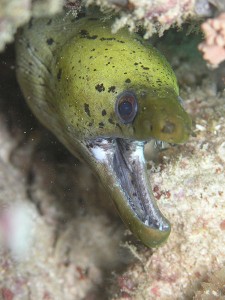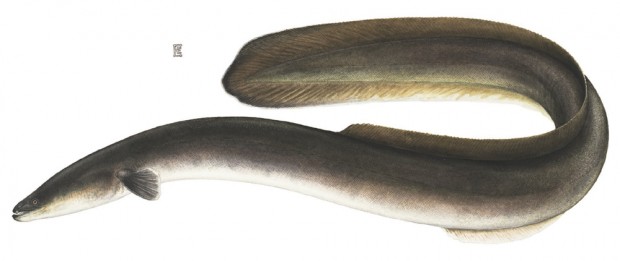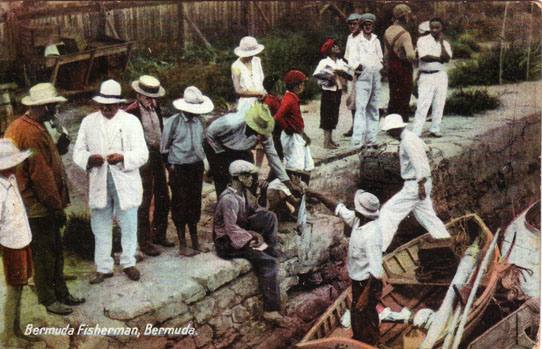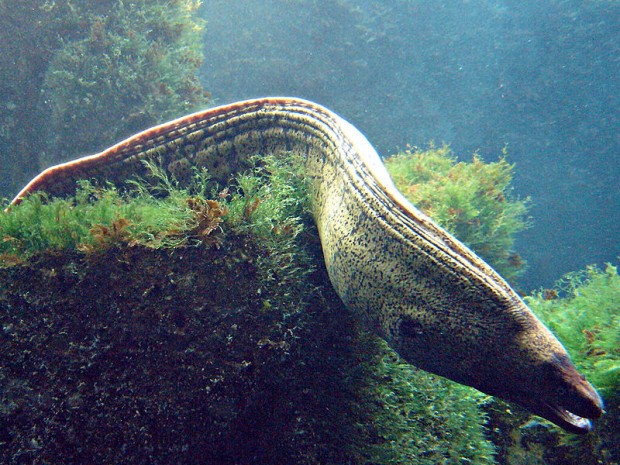Mystery Surrounds 1902 Bermuda ‘Sea Serpent’
 When it was captured seven miles off Bermuda in 1902, a previously unknown eel-type creature was described as a genuine sea monster in sensational newspaper reports which appeared across America.
When it was captured seven miles off Bermuda in 1902, a previously unknown eel-type creature was described as a genuine sea monster in sensational newspaper reports which appeared across America.
The live six-foot “sea serpent” — described as having “a warlike appearance” [not unlike the moray pictured at left] — was shipped to the New York aquarium so scientists could study it.
When it arrived in Battery Park facility in July, 1902, the “New York Times” carried a major report breathlessly headlined: “REAL SEA SERPENT IS HERE AT LAST; Uncanny Creature a Prisoner in the Aquarium. Sent from Bermuda by Prof. Bristol, Who Never Saw Its Like and Does Not Know How to Class It.”
“In tank number three of the south ground floor of the aquarium, there was deposited there the strangest creature the authorities of that institution have ever been called upon to take care of,” read the “Times” July 2 report. “The creature, which may be a snake or a moray or a deep sea eel or a sea serpent, arrived on the Quebec Line steamship ‘Trinidad’ and was sent north by Professor Charles L, Bristol, Professor of Biology at New York University, who is at present in Bermuda securing rare piscatorial specimens for the aquarium.
“The creature is about six feet long, has a reptilian head, the head of a moray, and the tail of a fish. Its body is of a rich brown, striped or spotted at regular intervals with beautiful bands and spots of a light yellow. That it is very much alive is shown by its lively movements in captivity.”
The newspaper’s account said the captive creature “is on the go all the time, sometimes whirling upward, then down or sideways, striking its head on the glass walls with considerable force …”
Professor Bristol was said to be baffled by the unusual specimen.
“He suggested it might be a species of the deep sea eel, but that was only a surmise and he frankly admitted that for once he had run across a fish or reptile which he had neither seen nor heard of before,” said “The Times.”
The American eel, which spawns in the Sargasso Sea, is most often mistaken for a “sea serpent”
Three “intoxicated Bermuda fishermen” were reported to have captured the creature a few weeks earlier near a ledge where the sea depth abruptly dropped off to 200 fathoms.
“[They] were about ready to return home when they thought it would be a wise thing to pull in a line that they had set some hours before,” reported the newspaper. “One of them grabbed the line and tried to pull it in but it became taut and refused to give …
“… While they were pulling with all their might the line suddenly eased and before any of them had a chance to realise what had happened, the ‘sea serpent’ had been pulled out of the water and into the boat.”
One of the fishermen, “a very superstitious fellow” according to the report, thought they had landed the devil and “cowered in the bottom of the boat praying and yelling for mercy.”
When the fishermen — “perfectly sober now” — had regained their composure, they put into St. George’s and delivered the creature to renowned Bermudian naturalist Louis Mowbray who kept it alive in a tidal pool.
Vintage hand-coloured postcard of Bermuda fishermen selling their catch
Mr. Mowbray, who built Boston’s aquarium in 1911 and then served as superintendent of New York’s aquarium before becoming founding curator of Bermuda’s aquarium in 1928, passed the specimen on to Professor Bristol for study.
The American scientist, a founder of the Bermuda Biological Station for Research [now BIOS], arranged for it to be shipped to New York along with other live specimens he caught in local watersfor that city’s aquarium.
Unfortunately, the sea creature was dead within a month of its arrival in New York; its body was preserved in formaldehyde so it could be further researched.
More than 30 years later two more specimens were caught off Bermuda and placed on display at the Bermuda Aquarium in Flatts.
“There is no question this species is entitled to the name sea serpent,” said Mr. Mowbray at the time.
Some species of moray have been identified as sea serpents in Bermuda waters
A 1934 newspaper report described the fish as striking “at its prey in a snake-like manner … [it] has no fins and crawls on the ocean bed among the coral reefs and rocks, 20 fathoms down.”
It is not clear if the specimens were ever formally identified. Dr. Ian Walker, current curator at the Bermuda Aquarium, Museum & Zoo, has said the majority of reported sea snakes in the island’s waters are either American eels — which spawn in the Sargasso Sea – or some variations of morays.
Wildly embellished reports of unusual sea creatures punctuate Bermuda’s history. In what was likely intended as an April Fool’s Day hoax, an account of a Bermuda sea monster written by a young Benjamin Franklin in 1736 enthralled newspaper readers throughout the 13 American colonies.
And when the carcass of a 30-foot long oarfish washed up on the South Shore in 1860 newspapers and magazines around the world carried hair-raising stories on the “Bermuda sea monster.”
Read More About
Category: All, Environment, History, News





shame theres no picture provided for the ‘sea serpent’. very interesting article though. I especially love it when other countries back in the 18th Centuries and around then mention Bermuda as did Ben Franklin in his writings.
So what exactly was it? I say a maybe but not definite answer